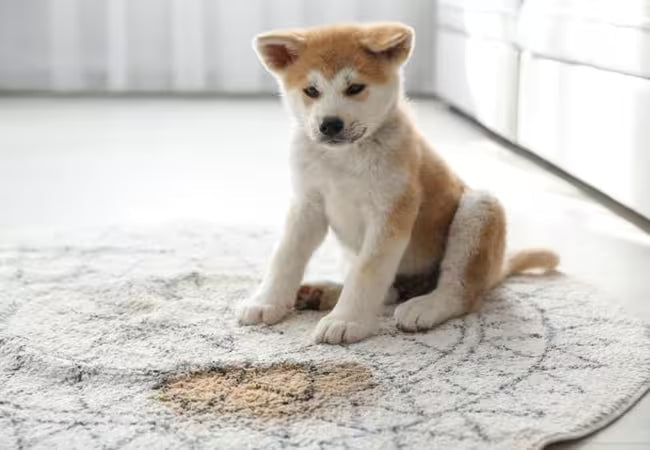How to Stop Your New Puppy from Peeing in the House in 2025 – Vet‑Approved Potty Training Guide 🐶🚽

In this article
How to Stop Your New Puppy from Peeing in the House in 2025 – Vet‑Approved Potty Training Guide 🐶🚽
By Dr. Duncan Houston BVSc
Bringing home a new puppy brings joy—and plenty of puppy puddles! House accidents are normal, but with patience, consistency, and vet‑backed strategies, you can guide your pup to reliable potty habits quickly. In this 2025 guide, I'll walk you through routines, cues, crate training, rewarding, mistake recovery, and health checks to help you create a confident, well‑trained pup. Let’s get started! 🐾
1. Understand Puppy Bladder Basics
- Puppies have small bladders and limited control—generally, they can hold about 1 hour for each month of age (e.g., a 2‑month‑old pup ≈ 2 hours) .
- Young pups often need to relieve themselves every 30–60 minutes, plus right after eating, drinking, playing, or waking .
- Nighttime control comes later—expect interruptions for very young pups.
2. Build a Consistent Potty Routine
- Take your puppy out early in the morning, before bedtime, and after meals, naps, and play.
- Use a designated spot outside to establish a familiar cue and scent.
- Choose a consistent cue word like “go potty” and use it each time—timing matters.
3. Crate Training: A Valuable Tool
Crates mimic den spaces—clean and close pups avoid soiling them:
- Pick a crate sized to allow standing, turning, and lying down—not too big.
- Crate during supervision lapses (e.g. mealtimes or sleeping times).
- Gradually extend crate duration for naps and overnight as bladder control improves.
4. Praise & Reward Every Success
- As soon as your pup eliminates outside, enthusiastically praise and reward with a treat or play.
- Keep rewards brief—puppies have short attention spans.
- Reward consistency builds a strong potty association.
5. Supervision & Mistake Prevention
- Watch for sniffing, circling, or squat postures—these are early signals.
- Stay close during play/nap times—use gates if needed.
- Limit unsupervised access—like long laps alone indoors.
6. Handle Indoor Accidents Gently
- If caught in the act, calmly interrupt, pick them up, and immediately take them outside.
- Avoid scolding—yelling can cause fear and confusion; they won’t connect punishment to the accident.
- Clean thoroughly with an enzyme cleaner to prevent scent-driven re-soiling.
7. Use Safe Indoor Potty Options
- For emergencies or young pups, offer indoor pads or indoor grass in a consistent, low-traffic corner.
- Transition slowly—move the pad toward the exit and eventually outdoors.
8. Track Progress & Accidents
Keep a simple diary noting time of meals, naps, potty trips, and accidents to identify patterns and urine-control improvements.
9. Check Health with Your Vet
Frequent accidents or sudden changes might indicate:
- Urinary tract infection (UTI)
- Congenital bladder issues
- Excessive water intake (polydipsia)
Discuss testing if your pup seems off-track despite training.
10. Boost Training with Confidence Steps
- Celebrate little milestones—longer hold times and fewer accidents outside.
- Encourage independence and confidence in outside pottying—especially in multiple-access homes.
- If setbacks occur, return to a stricter routine temporarily.
11. Handle Transitions & Interruptions
- Keep new caregiver routines consistent when away or using sitters.
- Maintain the same potty words and spot—even during veterinary stays.
- When travel occurs, treat new environments like a reset and repeat training steps.
12. Age-Appropriate Targets
- 2–4 months: •1–2 accidents/day; hold 2–4 hrs; remember every event.
- 4–6 months: •0–1 accidents/day; hold 4–6 hrs; fewer prompts needed.
- 6–9 months: •House-trained; hold up to 8 hrs; minimal outdoor prompts.
13. Common Mistakes & Tips
| Mistake | Why It Happens | Better Option |
|---|---|---|
| Inconsistent schedule | Leaves puppy confused | Set a strict routine ×2 weeks |
| Over-crating | Mess up potty control | Crate only ~bladder time + 1 extra hr |
| Punishment for accidents | Creates fear, not learning | Interrupt calmly & guide outside |
| Forgetting praise | Puppy doesn’t connect the action to the reward | Praise immediately after potty |
14. Troubleshooting: What to Do When Training Stalls
- Restart stricter routine—shorten supervision windows.
- Use a brief timeout or leash tethering when unsupervised.
- Consult a trainer or vet behaviorist if anxiety, marking, or other issues appear.
15. 🐾 Ask A Vet App 2025 Support
With the Ask A Vet app, you can:
- 📹 Upload videos of training sessions to get feedback.
- 🧩 Receive personalized routines and potty success plans.
- 🩺 Consult your vet if potty issues persist or health concerns arise.
Expert help ensures a smooth start to your puppy’s home journey. 🐾📲
❤️ Final Thoughts
Potty training a new puppy takes effort, but with consistent routine, positive reinforcement, patience, and veterinary support, you’ll build reliable habits and confidence—setting up a happy home life. Celebrate each success, stay calm during setbacks, and lean on expert guidance whenever you need it.
Need tailored help? Visit Ask A Vet.com or download the Ask A Vet app for on‑demand support with your puppy training journey.






